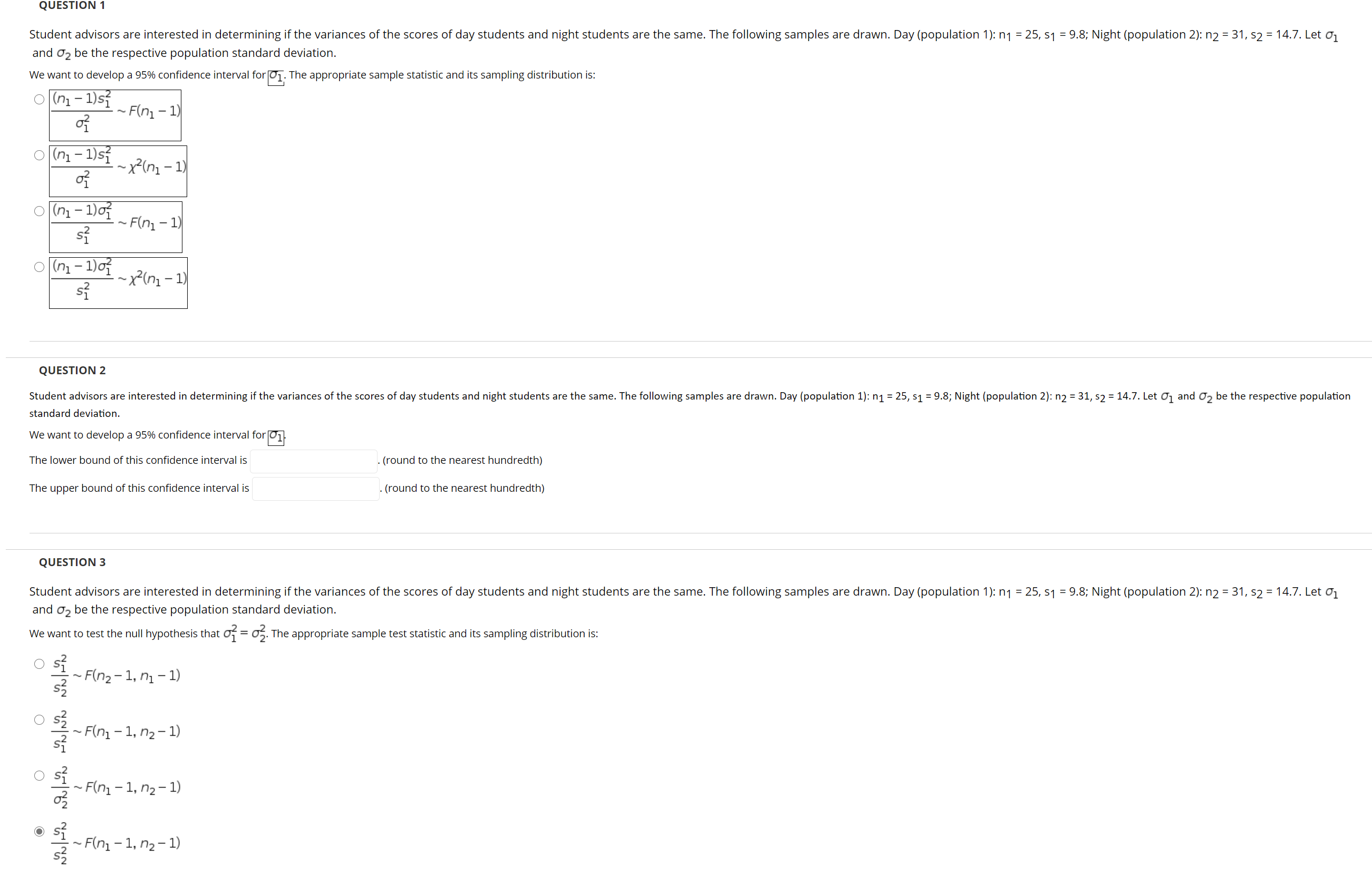Student advisors are interested in determining if the variances of the scores of day students and night students are the same. The following samples are drawn. Day (population 1): nj = 25, s1 = 9.8; Night (population 2): n2 = 31, s2 = 14.7. Let o1 and o2 be the respective population standard deviation. We want to develop a 95% confidence interval for 0. The appropriate sample statistic and its sampling distribution is: O (n - 1)s - F(n1 – 1) of O n - 1)si -~x²(n – 1)| ~ F(n – 1) [(n1-1)에 ~x²(n1 – 1) QUESTION 2 Student advisors are interested in determining if the variances of the scores of day students and night students are the same. The following samples are drawn. Day (population 1): n1 = 25, s1 = 9.8; Night (population 2): n2 = 31, s2 = 14.7. Let Oj and 0z be the respective population standard deviation. We want to develop a 95% confidence interval for 1 The lower bound of this confidence interval is . (round to the nearest hundredth) The upper bound of this confidence interval is - (round to the nearest hundredth)
Student advisors are interested in determining if the variances of the scores of day students and night students are the same. The following samples are drawn. Day (population 1): nj = 25, s1 = 9.8; Night (population 2): n2 = 31, s2 = 14.7. Let o1 and o2 be the respective population standard deviation. We want to develop a 95% confidence interval for 0. The appropriate sample statistic and its sampling distribution is: O (n - 1)s - F(n1 – 1) of O n - 1)si -~x²(n – 1)| ~ F(n – 1) [(n1-1)에 ~x²(n1 – 1) QUESTION 2 Student advisors are interested in determining if the variances of the scores of day students and night students are the same. The following samples are drawn. Day (population 1): n1 = 25, s1 = 9.8; Night (population 2): n2 = 31, s2 = 14.7. Let Oj and 0z be the respective population standard deviation. We want to develop a 95% confidence interval for 1 The lower bound of this confidence interval is . (round to the nearest hundredth) The upper bound of this confidence interval is - (round to the nearest hundredth)
Glencoe Algebra 1, Student Edition, 9780079039897, 0079039898, 2018
18th Edition
ISBN:9780079039897
Author:Carter
Publisher:Carter
Chapter10: Statistics
Section10.4: Distributions Of Data
Problem 19PFA
Related questions
Topic Video
Question
Please answer Q1 and Q2 in the image.

Transcribed Image Text:Student advisors are interested in determining if the variances of the scores of day students and night students are the same. The following samples are drawn. Day (population 1): nj = 25, s1 = 9.8; Night (population 2): n2 = 31, s2 = 14.7. Let o1
and o2 be the respective population standard deviation.
We want to develop a 95% confidence interval for 0. The appropriate sample statistic and its sampling distribution is:
O (n - 1)s
- F(n1 – 1)
of
O n - 1)si
-~x²(n – 1)|
~ F(n – 1)
[(n1-1)에
~x²(n1 – 1)
QUESTION 2
Student advisors are interested in determining if the variances of the scores of day students and night students are the same. The following samples are drawn. Day (population 1): n1 = 25, s1 = 9.8; Night (population 2): n2 = 31, s2 = 14.7. Let Oj and 0z be the respective population
standard deviation.
We want to develop a 95% confidence interval for 1
The lower bound of this confidence interval is
. (round to the nearest hundredth)
The upper bound of this confidence interval is
- (round to the nearest hundredth)
Expert Solution
This question has been solved!
Explore an expertly crafted, step-by-step solution for a thorough understanding of key concepts.
This is a popular solution!
Trending now
This is a popular solution!
Step by step
Solved in 2 steps

Knowledge Booster
Learn more about
Need a deep-dive on the concept behind this application? Look no further. Learn more about this topic, statistics and related others by exploring similar questions and additional content below.Recommended textbooks for you

Glencoe Algebra 1, Student Edition, 9780079039897…
Algebra
ISBN:
9780079039897
Author:
Carter
Publisher:
McGraw Hill

Glencoe Algebra 1, Student Edition, 9780079039897…
Algebra
ISBN:
9780079039897
Author:
Carter
Publisher:
McGraw Hill